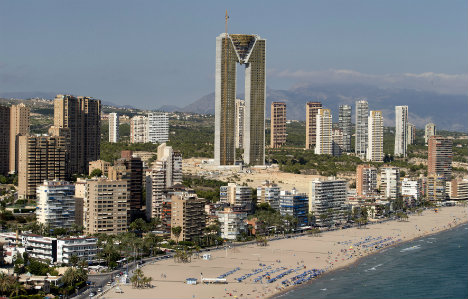Spain grows ever more popular with tourists every year with a record-breaking number of visitors to its shores in 2017 – 81.8 million in 2017 according to statistics from the World Tourism Organization – but after enjoying the sun, sea and sangria most head back home.
But how many foreigners actually choose to put down roots in Spanish soil and make Spain their permanent home?
If you take a trip to parts of the Costa Blanca or Costa del Sol it may seem as if it some towns are entirely populated by English-speaking communities but the official statistics provide a different story.
Spain is home to 46.5 million people and counts just over 10 percent of its population (4.7 million) as foreigners, with the top three nationalities in terms of size of population being Moroccan, Romanian and Chinese.
In fact native English speakers only represent around 7 percent of all the foreign-born residents in Spain. Brits may account for a sizeable proportion of that group but included in the community are Americans, Canadians, Irish, South Africans, Australians, New Zealanders and Indians.
The data is collected by Spain’s National Statistics Office (INE) from those registered on the padron, so it comes with a massive caveat, as despite the fact that being ‘empadronado’ allows you access to local services, many expats (and we use that term hesitantly) fail to register with the town hall.
Add to that the fact that many visitors only spend part of their year here, either owning holiday homes or escaping the dark northern winters of their home country for a place in the winter sun.
Valencia is the most popular region to live

Benidorm has the largest concentration of Brits in Spain. Photo: AFP
It will come as no surprise to learn that Benidorm IS the most concentrated population of native-English speaking residents.
The coastal resort is the epicentre of English speaking residents and forms part of a cluster of towns on the Costa Blanca where English-speakers – mostly Brits – call home. It is home to 2,222 Brits, which represents 3.4 percent of the total number of population.
In all, the Alicante province has the largest number of British residents in Spain. 67,000 are registered on the padron, meaning they make up the 3.4 percent of the province’s total population.
The region of Valencia has a total of 75,700 registered British residents but it also has 6,385 Indians, 2,720 Americans, 2,700 Irish, 505 Canadians, 293 Australians, 139 South Africans, and 96 New Zealanders.
Andalusia comes a close second

After the region of Valencia, the southern region of Andalusia is the most popular with Anglophones, more specifically the coastal stretches around Almeria and Malaga’s Costa del Sol.
Those English speakers registered as permanent residents in the region number 87,000 of whom almost 75,000 are originally from Britain.
The native-English speaking community in Andalusia is completed by 5,800 Americans, 3,500 Irish, 2,060 Indians, 762 Canadians, 382 Australians, 246 South Africans and 89 Kiwis.
Catalonia takes third place

Photo: AFP
Of those drawn to settling down in Catalonia, the city of Barcelona is by far the favourite destination.
Around 19,200 native English speakers have made their home in the Catalan’s capital. UK has the biggest representation in Barcelona, as there are more than 7,000 of them living in the city of La Sagrada Familia and Las Ramblas.
Catalonia is also home to 23,000 Indians, 13,500 Brits, almost 8,000 Americans, 2,000 Irish, 1,200 Canadians, 700 Australians, 300 South Africans and 180 New Zealanders.
Canary Islands prove popular
With year-round sunshine and gorgeous beaches, it’s no wonder so many foreigners are attracted to island life. 31,800 English-speaking foreigners to be exact and, yet again, the Brits make up the biggest part of the Anglophone community.
There are 25,000 Brits registered on the padron across the islands, while the remainder of the English-speaking community is made up of 3,600 Indians, 1,800 Irish, 950 Americans, 180 Canadians, 80 South Africans, 100 Australians and just 12 Kiwis.
Madrid is a favourite with Americans

Photo: Depositphotos
Spain’s capital is registered as home to 22,793 English natives and, for a change, Brits don’t make up the largest group of them.
In fact, Americans are the predominant English-speakers in the capital – all those young classroom assistants on the bilingual teaching programme boost numbers – with 10,000 visitors from across the pond choosing to make Madrid their home.
READ ALSO: The Ultimate A to Z Guide to Teaching English in Spain
Brits come in a close second with 9,500 registered on the padron, followed by 2,500 Indians, 1,600 Irish, 800 Canadians, 430 Australians and 100 Kiwis.
Balearic Islands
The Balearic islands are known around the world for the laidback island lifestyle, paradise beaches and party resorts.
It is also one of the favourite regions in Spain for native English speakers to set up residence.
In fact, more than 17,000 of them once decided to switch their residence to Ibiza, Mallorca and Menorca. Brits are the biggest Anglophone community in the islands, as there are 14,000 of them registered as living there.
Where can I be the only English speaker in the village?

Photo: AFP
If you have left your nation of birth to get away from fellow countrymen and embrace Spain and the Spanish way of life, then you probably ought to head to Extramadura or La Rioja, the two regions where the fewest English-speaking expats live.
Extremadura hosts barely 766 native English speakers while La Rioja is the least popular region with just 420 Anglophones registered.
Both regions lack coastal zones and do not stand out for their job opportunities, although if you love either jamon or vino and hate speaking English it could be the perfect spot for you!
Interactive map of Spain's native English speakers
Top 10 provinces by size of Anglophone population (British, Indians Americans, Canadians, Irish, South Africans, Australians, New Zealanders):
Alicante: 73,466
Málaga: 52,780
Barcelona: 40,449
Madrid: 25,272
Balearic Islands: 19,497
Las Palmas: 16,385
Murcia: 16,096
Santa Cruz de Tenerife: 15,490
Almería: 15,045
Valencia: 13,552
Data from INE valid on October 1st 2018
READ ALSO: These are the 17 absolute worst things about living in Spain





 Please whitelist us to continue reading.
Please whitelist us to continue reading.